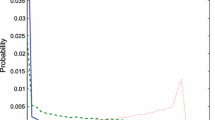Summary
Two numerical algorithms for the risk analysis of credit portfolios are presented. The first one determines the distribution of credit losses and is based on the fast Fourier transform. The algorithm has a strong analogy to the CreditRisk+ approach, since both the Poisson approximation as well as the technique of forming homogeneous exposure bands are being used. An application to the analysis of collateralized debt obligations is also given. The second algorithm makes use of an importance sampling technique for allocating credit risk contributions according to the risk measure expected shortfall. The coherent risk spectrum that is obtained by varying the loss exceedance level is introduced and its properties are discussed.
Access this chapter
Tax calculation will be finalised at checkout
Purchases are for personal use only
Preview
Unable to display preview. Download preview PDF.
Similar content being viewed by others
References
P. Artzner, F. Delbaen, J.-M. Eber, D. Heath. Coherent measures of risk. Mathematical Finance, 9 (3): 203–228, 1999.
R. B. Ash, C. A. Doléans-Dade. Probability and Measure Theory. Academic Press, San Diego, 2000.
A. D. Barbour. In D. N. Shanbhag, C. R. Rao, editors, Topics in Poisson Approximation, Elsevier Science, 2001.
Credit Suisse Financial Products. CreditRisk+: A credit risk management framework. London, 1997. Available at http: //ww. csfb. com/creditrisk.
M. B. Gordy. A comparative anatomy of credit risk models. Journal of Banking and Finance, 24: 119–149, 2000.
H. Koyluoglu, A. Hickman. Reconcilable differences. Risk, 11 (10): 56–62, 1998.
P. Jäckel. Monte Carlo Methods in Finance. Wiley Finance, 2002.
Martin, R. Martin, K. Thompson, C. Browne. Taking to the saddle. Risk, 14 (6): 91–94, 2001.
S. Merino, M. Nyfeler. Calculating portfolio loss. Risk, 15 (8): 82–86, 2002.
H: Panjer. Recursive evaluation of a family of compound distributions. ASTIN Bulletin, 12: 22–26, 1981.
Editor information
Editors and Affiliations
Rights and permissions
Copyright information
© 2004 Springer-Verlag Berlin Heidelberg
About this chapter
Cite this chapter
Merino, S., Nyfeler, M. (2004). Numerical Techniques for Determining Portfolio Credit Risk. In: Gundlach, M., Lehrbass, F. (eds) CreditRisk+ in the Banking Industry. Springer Finance. Springer, Berlin, Heidelberg. https://doi.org/10.1007/978-3-662-06427-6_17
Download citation
DOI: https://doi.org/10.1007/978-3-662-06427-6_17
Publisher Name: Springer, Berlin, Heidelberg
Print ISBN: 978-3-642-05854-7
Online ISBN: 978-3-662-06427-6
eBook Packages: Springer Book Archive




